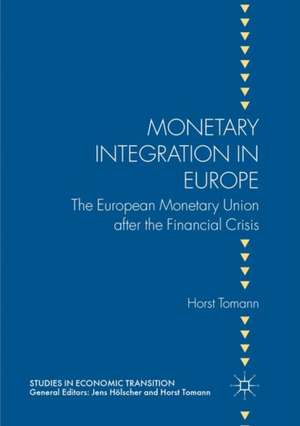Monetary Integration in Europe: The European Monetary Union after the Financial Crisis: Studies in Economic Transition
Autor Horst Tomannen Limba Engleză Paperback – 22 aug 2018
| Toate formatele și edițiile | Preț | Express |
|---|---|---|
| Paperback (1) | 681.73 lei 38-44 zile | |
| Springer International Publishing – 22 aug 2018 | 681.73 lei 38-44 zile | |
| Hardback (1) | 732.40 lei 6-8 săpt. | |
| Springer International Publishing – 4 oct 2017 | 732.40 lei 6-8 săpt. |
Din seria Studies in Economic Transition
- 20%
 Preț: 695.04 lei
Preț: 695.04 lei - 15%
 Preț: 643.34 lei
Preț: 643.34 lei - 15%
 Preț: 649.54 lei
Preț: 649.54 lei - 15%
 Preț: 643.00 lei
Preț: 643.00 lei - 18%
 Preț: 782.42 lei
Preț: 782.42 lei - 15%
 Preț: 643.48 lei
Preț: 643.48 lei -
 Preț: 390.63 lei
Preț: 390.63 lei - 15%
 Preț: 642.51 lei
Preț: 642.51 lei - 15%
 Preț: 643.65 lei
Preț: 643.65 lei -
 Preț: 386.39 lei
Preț: 386.39 lei - 15%
 Preț: 636.30 lei
Preț: 636.30 lei - 15%
 Preț: 639.08 lei
Preț: 639.08 lei - 15%
 Preț: 640.37 lei
Preț: 640.37 lei - 15%
 Preț: 644.95 lei
Preț: 644.95 lei - 15%
 Preț: 637.13 lei
Preț: 637.13 lei - 18%
 Preț: 944.99 lei
Preț: 944.99 lei - 15%
 Preț: 642.51 lei
Preț: 642.51 lei -
 Preț: 395.25 lei
Preț: 395.25 lei -
 Preț: 388.72 lei
Preț: 388.72 lei -
 Preț: 392.37 lei
Preț: 392.37 lei - 15%
 Preț: 640.71 lei
Preț: 640.71 lei -
 Preț: 394.51 lei
Preț: 394.51 lei - 15%
 Preț: 643.84 lei
Preț: 643.84 lei - 18%
 Preț: 731.59 lei
Preț: 731.59 lei - 15%
 Preț: 647.27 lei
Preț: 647.27 lei - 15%
 Preț: 642.18 lei
Preț: 642.18 lei - 15%
 Preț: 636.80 lei
Preț: 636.80 lei -
 Preț: 391.61 lei
Preț: 391.61 lei - 15%
 Preț: 638.43 lei
Preț: 638.43 lei - 15%
 Preț: 640.24 lei
Preț: 640.24 lei - 15%
 Preț: 643.84 lei
Preț: 643.84 lei - 15%
 Preț: 645.96 lei
Preț: 645.96 lei - 15%
 Preț: 635.47 lei
Preț: 635.47 lei - 15%
 Preț: 644.95 lei
Preț: 644.95 lei - 15%
 Preț: 644.95 lei
Preț: 644.95 lei
Preț: 681.73 lei
Preț vechi: 749.15 lei
-9% Nou
Puncte Express: 1023
Preț estimativ în valută:
130.49€ • 141.79$ • 109.68£
130.49€ • 141.79$ • 109.68£
Carte tipărită la comandă
Livrare economică 17-23 aprilie
Preluare comenzi: 021 569.72.76
Specificații
ISBN-13: 9783319865805
ISBN-10: 3319865803
Pagini: 246
Ilustrații: XVII, 246 p. 22 illus., 10 illus. in color.
Dimensiuni: 148 x 210 mm
Ediția:Softcover reprint of the original 2nd ed. 2017
Editura: Springer International Publishing
Colecția Palgrave Macmillan
Seria Studies in Economic Transition
Locul publicării:Cham, Switzerland
ISBN-10: 3319865803
Pagini: 246
Ilustrații: XVII, 246 p. 22 illus., 10 illus. in color.
Dimensiuni: 148 x 210 mm
Ediția:Softcover reprint of the original 2nd ed. 2017
Editura: Springer International Publishing
Colecția Palgrave Macmillan
Seria Studies in Economic Transition
Locul publicării:Cham, Switzerland
Cuprins
Chapter 1: The History of Monetary Integration in Europe.- Part I: The Functioning of the Monetary Union. Chapter 2: Theory of Optimum Currency Areas.- Chapter 3: The Economic and Monetary Union: Institutions and Credibility.- Chapter 4: Conventional Monetary Policy of the ECB.- Chapter 5: Fiscal Policy Coordination and the Stability and Growth Pact.- Chapter 6: The EMU and the Wage Bargain.- Part II: Responses to the Financial Crisis. Chapter 7: The ECB’s Unconventional Monetary Policy.- Chapter 8: The Burden of Public Debt and the European Stability Mechanism.- Chapter 9: The Banking Union and Financial Stability.- Part III: Long-term Issues. Chapter 10: Real Convergence in a Monetary Union.- Chapter 11: The New European Monetary System.- Chapter 12: The Debate on Reform Options.
Notă biografică
Horst Tomann is Professor Emeritus at Freie University Berlin, Germany. He previously held the Jean Monnet Professorship for European Economic Policy at Freie University and was a staff member at the German Council of Economic Experts. He has had several appointments as Visiting Professor, among others at the University of Pennsylvania (Wharton School), USA, and the University of Birmingham, UK. He is the co-editor of Palgrave Macmillan’s book series Studies in Economic Transition, and the Palgrave Dictionary of Emerging Markets and Transition Economics, both alongside Jens Hӧlscher.
Textul de pe ultima copertă
This book provides a fully revised and up-to-date analysis of the Economic and Monetary Union (EMU). With four entirely new chapters on responses to the financial crisis and the debate on reform options, Tomann assesses the EMU in comparison with other currency regimes through the adoption of a historical analysis. The book discusses in detail basic issues with currency and comprehensively analyzes monetary policy, highlighting problems of policy coordination. Tomann explores new monetary institutions that have been established in response to the financial crisis, before addressing long-term issues and reviewing reform proposals. By focusing on monetary issues the book offers a better understanding of macroeconomic policies and international policy cooperation, and, by extension, provides a thorough economic assessment of the EMU as an institution as it stands today.
Caracteristici
A second edition of Money Integration in Europe with a new focus on the European Monetary Union crisis Addresses the burden of public debt Assesses the reform options for the EMU
